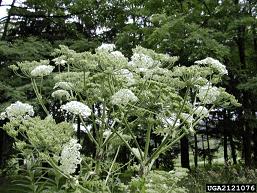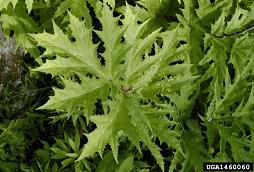
| |
Giant Hogweed (Heracleum mantegazzianum) | |
| |
|
|
| |
|
|
| | Return to the Weed Information Home Page
.
Caution
Description
Grows up to 6 meters or more. Aside from its immense size, giant hogweed is also distinguished by its stout, dark reddish stem that can grow 5 cm to 10 cm in diameter. Leaf stalks are spotted and produce a compound leaf that can expand to 1.5 meters across. Each leaflet is deeply grooved or divided. Both stems and stalks are hollow and produce coarse hairs around a blister like pustule. Each year tuberous root-stalks form long-lived buds. In summer small, white flowers form together to make up an inflorescence or umbrella-shaped head that can attain a diameter of almost 1 meter. Warning: Its watery, clear sap contains photosensitizing compounds (furanocoumarins), which, when in contact with human skin and in combination with UV radiation, can cause burning.
Key Identifiers
- Up to 6 m in height
- Leaves up to 1.5 m across
- Flower head up to 1 m across
- Reddish-purple blotches and stiff hairs on stem
Location in Canada
Prevalent populations in British Columbia and Ontario. With smaller populations in Quebec, New Brunswick, Nova Scotia and Newfoundland. All reports in Alberta have proven to be inaccurate. | 
Thomas B. Denholm, New Jersey Department of Agriculture, Bugwood.org |

Donna R. Ellis, University of Connecticut, Bugwood.org |
Resources
Similar species
Giant hogweed has been mistaken for other species, especially other members of the carrot family. These species include; Cow Parsnip (Heracleum lanatum), Wild carrot (Daucus carota), Goutweed (Aegopodium podagraria), poison hemlock (Conium maculatum), water-parsnip (Sium suave), spotted water-hemlock (Cicuta maculata) and angelica (Angelica atropurpurea). Its "giant" size is the easiest distinguishing feature, as it towers above these other species. |
|
| |
|
|
| |
Other Documents in the Series |
|
| |
Garlic Mustard (Alliaria petiolata)
Giant Hogweed (Heracleum mantegazzianum) - Current Document
|
|
| |
|
|
| |
For more information about the content of this document, contact Chris Neeser.
This document is maintained by Shelley Barkley.
This information published to the web on April 10, 2012.
Last Reviewed/Revised on August 21, 2018.
|
|